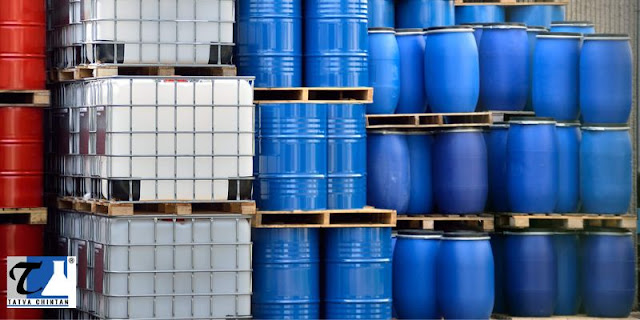What Is the best way to store TETRA ETHYL AMMONIUM HYDROXIDE AQ. SOLUTION?
As a robust organic base, TETRA ETHYL AMMONIUM HYDROXIDE has applications in transesterification catalysts, selective etching, flat panel display chemicals, advanced ceramics, and photovoltaic chemicals. Despite its industrial applications, it should be handled and stored carefully because it can harm human health and destroy properties.
How to store TETRA ETHYL AMMONIUM HYDROXIDE Aq. Solutio
Due to its complex chemical processes, an organic base like TETRA ETHYL AMMONIUM HYDROXIDE can damage human flesh, stone, and metal. As a result, the storage of this chemical should follow these principles:
- Separation: Due to the reactivity and toxicity of chemicals like this, TETRA ETHYL AMMONIUM HYDROXIDE should be kept away from unsuitable conditions. Using storage cabinets that separate classes of incompatible chemicals can help achieve this. Separating them physically into different structures is another effective method.
- Segregation: Strong bases must not be kept close to strong acids. This is just how flammable and organic materials should be kept from strong oxidizers. TETRA ETHYL AMMONIUM HYDROXIDE should also be kept away from other unsuitable materials because the aqueous solution is flammable.
- Ventilation: Ventilation is another essential requirement for safely storing a chemical like a TETRA ETHYL AMMONIUM HYDROXIDE AQUEOUS SOLUTION. Ventilation enables the diffusion and extraction of gases or vapors that may evacuate from containers.
In addition to these three major requirements, there are other ways to store TETRA ETHYL AMMONIUM HYDROXIDE AQUEOUS SOLUTION safely. Here are the different ways:
1. Safe flammable storage
This chemical and other flammable substances should be kept in rack storage or other authorized, designated volatile storage. Additionally, the facilities they are kept must be equipped with sprinkler systems.
Also, the storage area must be clear of smoke, open flames, and sparks. Storage drums need to have pressure-relief venting caps installed in them.
2. Tightly sealed containers
Another way of safely storing this chemical is by tightly sealing the storage container and keeping the container off the floor. Whether fumes or liquids, this system helps prevent leaks.
Additionally, storing the container on the racks should not be above eye level. At the appropriate height, it must also be tightly secured to the walls. Before the transfer, the storage facility should have spillage barriers or drains specifically designed for this purpose.
3. Temperature control
The manufacturers of flammable chemicals, such as the ETHYL AMMONIUM HYDROXIDE AQUEOUS SOLUTION, will specify the maximum and minimum temperature required for practical storage. There must be adherence to all these requirements.
This chemical can also be prevented from freezing when placed in a temperature-controlled storage facility. This is helpful as it will prevent overheating or making the container crack.
Overheating can make an aqueous solution like this more volatile. Therefore, the storage should be in specially designed refrigerators with regular temperature logging and monitoring.
4. Managing inventory
When storing flammable chemicals, there are statutory requirements you must meet. In addition to workplace safety, it will prevent non-compliance issues. At the very least, once a year, you should have a trained staff that would conduct a thorough inventory of every container, closet, cabinet, and corner.
Also, this chemical must be clearly labeled with the storage requirements and potential risks as recommended in the SDS. As various types of peroxidizable compounds may become highly volatile in a few months, their expiration dates should be strictly adhered to.
Furthermore, purchasing and storing this substance should be kept to a bare minimum. For all these reasons, managing inventory could be done through chemical inventory software or outsourced to a trained professional. Either way, the process will be streamlined, and this chemical will be more secure.
5. Chemical bunding
In case of an unforeseen circumstance or emergency, chemical bunds are vital to safeguarding and containing leaks and spills of this aqueous solution. They are trays that should be the first line of defense protecting the employees and the environment. Therefore, they must be placed beneath the container holding the TETRA ETHYL AMMONIUM HYDROXIDE AQUEOUS SOLUTION.
In some parts of the world, including the UK, using chemical bunds to store flammable and hazardous chemicals is a standard safety practice. Also, all bunds should be inspected once every three years. This is to ensure their effectiveness.
Risks associated with improper storage of TETRA ETHYL AMMONIUM HYDROXIDE AQUEOUS SOLUTION
Substances like TETRA ETHYL AMMONIUM HYDROXIDE AQUEOUS SOLUTION must be properly handled and stored. There are many risks associated with not keeping them properly. Some of the significant dangers may include the following:
- They contaminate the environment and make it unsafe for laboratory workers, staff, and cleaners.
- In the event of an incident, it may be difficult for emergency services to enter the laboratory or building because of how poorly or uncertainly the TETRA ETHYL AMMONIUM HYDROXIDE AQUEOUS SOLUTIO or other chemicals are stored.
- The presence of other explosive materials in the environment where this chemical is kept can aggravate any incident. A situation that should have been easily controlled may spiral out of control due to improper storage of this chemical.
- Combining TETRA ETHYL AMMONIUM HYDROXIDE AQUEOUS SOLUTIO with incompatible chemicals can cause unwanted reactions. This could lead to toxic exposure or physical damage from vapors, gases, fumes, and heat that can cause explosions or fire.
Conclusion
TETRA ETHYL AMMONIUM HYDROXIDE AQUEOUS SOLUTIO is a flammable substance and must be secured and properly stored. When storing this substance, it must be segregated from other classes of incompatible goods. In addition to separation and proper ventilation, the container must be well-sealed, chemical bunding must be used, and the temperature of the storage facility must be controlled.






Comments
Post a Comment